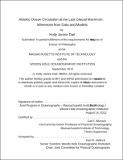Atlantic Ocean circulation at the last glacial maximum : inferences from data and models
Author(s)
Dail, Holly Janine
DownloadFull printable version (12.53Mb)
Other Contributors
Woods Hole Oceanographic Institution.
Advisor
Carl I. Wunsch.
Terms of use
Metadata
Show full item recordAbstract
This thesis focuses on ocean circulation and atmospheric forcing in the Atlantic Ocean at the Last Glacial Maximum (LGM, 18-21 thousand years before present). Relative to the pre-industrial climate, LGM atmospheric CO₂ concentrations were about 90 ppm lower, ice sheets were much more extensive, and many regions experienced significantly colder temperatures. In this thesis a novel approach to dynamical reconstruction is applied to make estimates of LGM Atlantic Ocean state that are consistent with these proxy records and with known ocean dynamics. Ocean dynamics are described with the MIT General Circulation Model in an Atlantic configuration extending from 35°S to 75°N at 1° resolution. Six LGM proxy types are used to constrain the model: four compilations of near sea surface temperatures from the MARGO project, as well as benthic isotope records of [delta]¹⁸O and [delta]¹³C compiled by Marchal and Curry; 629 individual proxy records are used. To improve the fit of the model to the data, a least-squares fit is computed using an algorithm based on the model adjoint (the Lagrange multiplier methodology). The adjoint is used to compute improvements to uncertain initial and boundary conditions (the control variables). As compared to previous model-data syntheses of LGM ocean state, this thesis uses a significantly more realistic model of oceanic physics, and is the first to incorporate such a large number and diversity of proxy records. A major finding is that it is possible to find an ocean state that is consistent with all six LGM proxy compilations and with known ocean dynamics, given reasonable uncertainty estimates. Only relatively modest shifts from modern atmospheric forcing are required to fit the LGM data. The estimates presented herein succesfully reproduce regional shifts in conditions at the LGM that have been inferred from proxy records, but which have not been captured in the best available LGM coupled model simulations. In addition, LGM benthic [delta]¹⁸O and [delta]¹³C records are shown to be consistent with a shallow but robust Atlantic meridional overturning cell, although other circulations cannot be excluded.
Description
Thesis (Ph. D.)--Joint Program in Oceanography (Massachusetts Institute of Technology, Dept. of Earth, Atmospheric, and Planetary Sciences; and the Woods Hole Oceanographic Institution), 2012. This electronic version was submitted by the student author. The certified thesis is available in the Institute Archives and Special Collections. Cataloged from student-submitted PDF version of thesis. Includes bibliographical references (p. 221-236).
Date issued
2012Department
Joint Program in Oceanography; Woods Hole Oceanographic Institution; Massachusetts Institute of Technology. Department of Earth, Atmospheric, and Planetary SciencesPublisher
Massachusetts Institute of Technology
Keywords
Joint Program in Oceanography., Earth, Atmospheric, and Planetary Sciences., Woods Hole Oceanographic Institution.